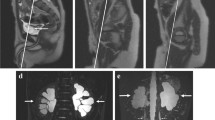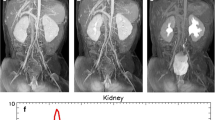Abstract
Modern MR urography is performed on the basis of two different imaging strategies, which can be used complementarily to cover almost all aspects in the diagnosis of upper urinary tract diseases. The first technique utilizes unenhanced, heavily T2-weighted pulse sequences to obtain static-fluid images of the urinary tract. T2-weighted MR urograms have proved to be excellent in the visualization of the markedly dilated urinary tract, even if the renal excretory function is quiescent. Static-fluid MR urography is less suitable for imaging of disorders that occur in the nondilated collecting system. The second MR urography technique is analogous to the methodology of conventional intravenous pyelography and is, therefore, designated as excretory MR urography. For this purpose, a non-nephrotoxic gadolinium chelate is intravenously administered and after its renal excretion, the gadolinium-enhanced urine is visualized using fast T1-weighted gradient-echo sequences. The combination of gadolinium and low-dose furosemide (5–10 mg) is the key for achieving a uniform distribution of the contrast material inside the entire urinary tract and, secondly, to avoid high endoluminal gadolinium concentrations, which cause signal loss of the urine due to T2* effects. Gadolinium excretory MR urography allows to obtain high-quality images of both nondilated and obstructed urinary tracts in patients with normal or moderately impaired renal function. This article reviews the principles of T2- and T1-weighted MR urography in detail and informs how to use these techniques safely in potential clinical applications such as chronic urolithiasis, intrinsic and extrinsic tumor diseases, and congenital anomalies. Magnetic resonance urography performed in combination with standard MR imaging offers a potential to reduce the need for invasive retrograde pyelography. Although the economic aspect is still problematic, it is obvious that MR urography will continue to increase its role in clinical uroradiology.
Similar content being viewed by others
Author information
Authors and Affiliations
Additional information
Received: 7 July 2000 Revised: 21 August 2000 Accepted: 21 August 2000
Rights and permissions
About this article
Cite this article
Nolte-Ernsting, C., Adam, G. & Günther, R. MR urography: examination techniques and clinical applications. Eur Radiol 11, 355–372 (2001). https://doi.org/10.1007/s003300000685
Issue Date:
DOI: https://doi.org/10.1007/s003300000685




